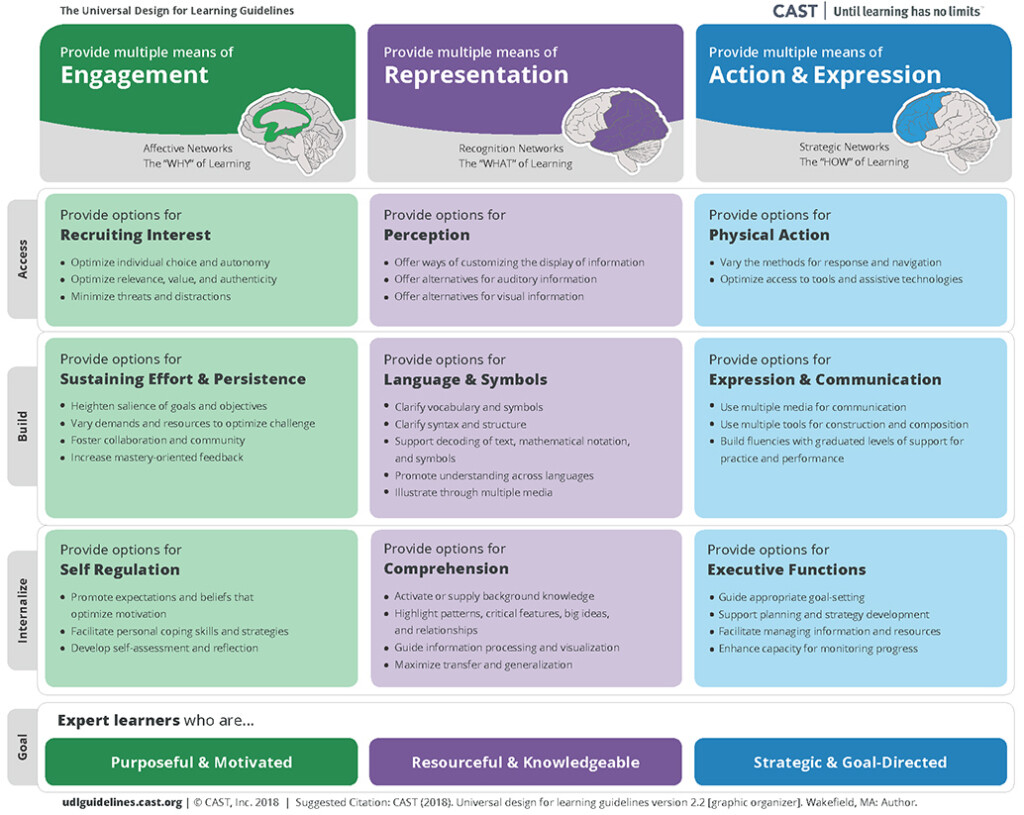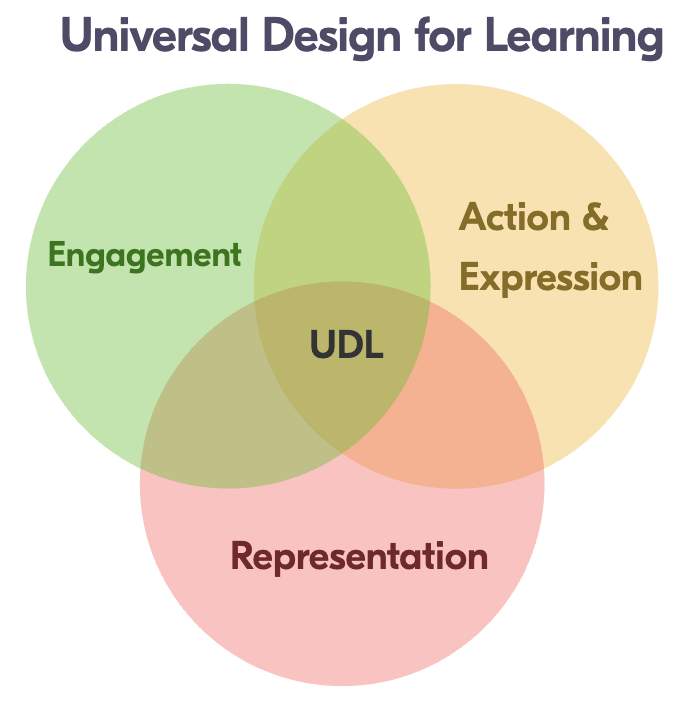What is Universal Design for Learning (UDL)?
Universal Design for Learning (UDL) is an educational framework created by David H. Rose, Ed.D. of the Harvard Graduate School of Education, and the Center for Applied Special Technology (CAST), that seeks to provide all learners with access to an inclusive learning environment. The guiding principle of UDL is that every student has a unique ability to learn, and that one-size-fits-all instruction is doomed to leave some students behind. UDL encourages curriculum developers to create a flexible curriculum that can be adapted to accommodate the varying types of learners and their individual learning styles, goals, and needs. This is done by giving the curriculum designers a set of principles for curriculum development which should be incorporated into the design of products and learning materials.
For example, UDL provides concrete suggestions and graphic organizers to help instructional designers create effective learning environments that are tailored towards the various kinds of learners, including expert learners, strategic networkers, and affective networkers. By providing scientific insights into how people learn best, UDL aims to maximize student learning outcomes while minimizing barriers in the learning process. This increasingly popular concept among educators offers the potential for creating inclusive opportunities for students, through universal design principles and assistive technologies.
The Benefits of UDL
Students benefit when a curriculum is designed to be delivered in a variety of methods which can be adapted according to individual learning goals, styles, needs, and types of learners. Without customizable learning experiences, students are forced to struggle as they work at the pace the educator chooses, rather than their own. When a student’s education is personalized, they are better engaged, and academic achievement usually increases.
Encouraging students to take an interest in their education is crucial as it has beneficial outcomes for their grit and academic achievements. In their paper “Personalized Education to Increase Interest”, Reber, et al, detail study after study discussing this educational truth. UDL builds on personalized curriculum and extends it to the presentation and expression of education, to describe a truly personalized education. It incorporates many educational best practices, including cognitive load theory, educational scaffolding, active learning, and diagnostic assessment to determine fundamental skill gaps and strengths.
Implement UDL for your students!
The benefits of Universal Design for Learning are numerous, including improved learner motivation, increased engagement in the learning process, greater understanding of material, increased self-direction in acquiring knowledge, improved collaboration among peers, better critical thinking skills as well as enhanced problem-solving abilities. Ultimately, UDL encourages educators to customize their instructional methods based on individual student needs for a more inclusive education system.
UDL seeks to create an environment of inclusion by utilizing flexible learning environments, curriculum, instructional methods, and technologies that are accessible to all students regardless of their learning styles or abilities. UDL utilizes graphic organizers and concrete suggestions to help teachers design their lessons in a way that accommodates different types of learners, from expert learners to beginners. By utilizing UDL strategies, teachers can provide meaningful learning experiences for each student, as well as cultivate an inclusive classroom environment where everyone feels supported. Incorporating UDL principles into instruction is a key step toward helping every student reach their maximum potential in the classroom.
In addition to its applications in the general student population, UDL offers the best set of guiding principles for teaching students with disabilities and special education needs, and is in fact specifically identified in The Individuals with Disabilities Education Act (IDEA) of 1990. UDL helps people with disabilities, as well as English language learners and other student populations with specific academic needs. The Dartmouth Center for the Advancement of Learning notes that instruction should be “designed with consideration for appropriate size and space for approach, reach, manipulations, and use regardless of a student’s body size, posture, mobility, and communication needs.”
The Science Behind UDL
The science behind Universal Design for Learning is an innovative approach to learning, and has been in development only since the 1990s. Through the use of a three-part cognitive framework – affective network, strategic network and knowledge network – UDL identifies key areas of development in order to inform optimal instructional practices. Additionally, UDL takes into account learner variability by providing concrete suggestions for different types of learners. Utilizing graphic organizers, teachers can customize instruction plans in order to meet the needs of individual students. With its evidence-based strategies and research insights, UDL provides educators with the tools necessary for creating successful classrooms and helping students reach their full potential.

A UDL graphic organizer from CAST (2018), version 2.2. Wakefield, MA: Author.
Strategic Network
The strategic network of UDL is the foundation upon which other UDL networks are built. This framework allows educators to create a flexible curriculum that takes into account the variability of learners and their abilities. Through UDL, teachers are able to identify strengths and weaknesses in each student by utilizing expert learners’ data-driven insights and graphic organizers. By leveraging this information, teachers can design instruction tailored to each student’s needs while also taking advantage of assistive technologies where necessary. With the use of edtech software, teachers can build customized learning paths for each student with the click of a button.
Cognitive Network
The cognitive network is the foundation of UDL and provides the framework for instruction. This three-part network focuses on affective, strategic, and knowledge elements of learning. Affective components focus on emotions, attitudes, and motivations that impact learning. Strategic networks emphasize the learner’s ability to make decisions concerning their approach to learning tasks. Knowledge networks explore how prior experiences can assist in understanding new information and skills. By considering these components together, teachers are able to create an inclusive environment tailored to meet the needs of all learners. Through an evidence-based design process, UDL facilitates expert learners by providing them with flexible curriculum options as well as access to assistive technologies for those who require it. Ultimately, UDL seeks to create meaningful learning goals and outcomes for students across a wide range of abilities and backgrounds.
Affective Network
The affective network of Universal Design for Learning is an important aspect of the overall cognitive network and focuses on emotions, attitudes, and motivations that can impact learning. This helps to create a more inclusive environment that takes into account the individual needs of learners, including their cultural, social and emotional needs. Through an evidence-based approach, UDL enhances the learning experience for all students by considering their emotional states as well as any prior experiences they may have. By understanding how emotions can play a role in learning, teachers are able to better tailor instruction to meet the needs of each student and create meaningful learning outcomes. With UDL’s affective network, teachers are able to build personalized learning environments where all students can thrive academically.
Educational Strategies Within UDL
Many instructional strategies are commonly used with Universal Design for Learning. UDL emphasizes that all learners are unique and should be able to access educational resources regardless of their abilities or needs. Some of those strategies include:
- engaging students
- providing multiple means of representation
- offering multiple means of action and expression
- providing multiple means of engagement
- emphasizing recognition over recall
- optimizing individual choice and autonomy
- fostering collaboration among students
- promoting understanding through feedback
- leveraging technology for instruction

UDL also promotes the use of assistive technologies and graphic organizers to aid in learning outcomes.
By using these strategies, teachers can create a learning environment that is accessible to all types of learners while also providing the best possible learning outcomes. UDL has been proven successful in helping students reach their full potential by tailoring instruction to the individual student’s strengths and weaknesses. CAST provides a nice 1-page handout illustrating these strategies
The University of Washington’s Center for Universal Design in Education has developed 7 Principles of Universal Design, which it defines as:
- equitable use
- flexibility of use
- simple and intuitive use
- perceptible information
- tolerance for error
- low physical effort
- size and space for approach and use
In their work with adults, educators at the University of Connecticut added “a community of learners” and “a strong instructional climate” to this list (Scott, 2003), and those principles can also be applied to K-12 students.
Curriculum developers are tasked with the responsibility of creating an instructional framework that meets the needs of all students. Universal Design for Learning (UDL) provides a beneficial framework for curriculum design to ensure that materials and instruction are accessible to all types of learners. Through its concrete suggestions on how to create flexible curricula for expert learners and novices alike, developers can help foster an inclusive educational environment that encourages student growth.
What are Graphic Organizers?
Graphic organizers are a key feature of Universal Design for Learning (UDL) and help coordinate all the information needed within the framework. Graphic organizers help learners process information and represent ideas in an easily comprehensible format. UDL’s strategic network of affective, cognitive, and physical components can be used to create graphic organizers that address all types of learner variability. Through this approach, learners can better navigate their learning environment, understand their learning goals, and achieve successful outcomes.
Graphic organizers help illustrate connections among information, principles, or notions, and assist in thought processing. This is an important issue for instructional designers to understand, because many students who could be classified as visual learners are also diagnosed with learning disabilities.
Examples of graphic organizers include flow charts, Venn diagrams, concept maps, t-charts, and any visual representation showing the connections or comparisons between ideas and processes.
Assistive Technologies Used in UDL
Assistive technologies play an integral role in Universal Design for Learning (UDL) instructional methods. These tools are designed to help individuals with disabilities or other special needs access information more effectively. Assistive technologies can range from simple accommodations, such as text-to-speech software or colored overlays, to more complex devices, such as high-tech augmentative communication systems. Additionally, assistive technology can also provide students with a variety of digital tools that allow them to interact with their learning environment in a meaningful way. With the right combination of UDL approaches and assistive technology, teachers can ensure every student has access to a quality education and experience success in the classroom.
Easily identify strengths and weaknesses
The Challenges of Applying Universal Design for Learning
Universal Design for Learning (UDL) provides a powerful framework to create a learning environment that works for all learners. However, UDL’s success depends on the effective implementation of its principles. This can be difficult due to various barriers, such as limited access to resources, lack of teacher training opportunities, and difficulty in adapting existing curricula. To ensure successful implementation of UDL principles, educators must have access to adequate resources and support services. Additionally, curriculum developers should tailor their instructional methods to meet the needs of different types of learners. Finally, educational institutions must provide teachers with professional development opportunities focused on UDL so they can better understand the framework and its implications for student learning outcomes. Through these steps, educators can ensure that UDL is applied properly and enables students from all backgrounds to reach their potential in the classroom.
UDL has the potential to revolutionize education if it is applied correctly, but the application of UDL principles can be a complex process. By providing teachers with the resources and training opportunities needed to understand and effectively apply UDL principles, educational institutions can ensure that their curriculum developers are equipping students with the skills necessary for success in their studies. Schools must “walk the talk” of recognizing learner variability, while understanding the importance of affective and strategic networks.
References
- https://udlguidelines.cast.org/
- https://www.washington.edu/doit/equal-access-universal-design-instruction
- https://dcal.dartmouth.edu/resources/teaching-methods/universal-design-education
- https://www.ncbi.nlm.nih.gov/pmc/articles/PMC6715310/
- https://education.ky.gov/educational/diff/pages/udl.aspx
- Dalton, Elizabeth M. “Beyond Universal Design for Learning: Guiding Principles to Reduce Barriers to Digital & Media Literacy Competence.” Journal of Media Literacy Education, National Association for Media Literacy Education. 10 Laurel Hill Drive, Cherry Hill, NJ 08003. Tel: 888-775-2652; e-Mail: Editor@Jmle.org; Web Site: Http://Digitalcommons.uri.edu/Jmle/, 30 Nov. 2016, https://eric.ed.gov/?id=EJ1160465.; https://files.eric.ed.gov/fulltext/EJ1160465.pdf.
- Scott, Sally & Mcguire, Joan & Shaw, Stan. (2003). Universal Design for Instruction: A New Paradigm for Adult Instruction in Postsecondary Education. Remedial and Special Education – REM SPEC EDUC. 24. 369-379. 10.1177/07419325030240060801.


Leave A Comment